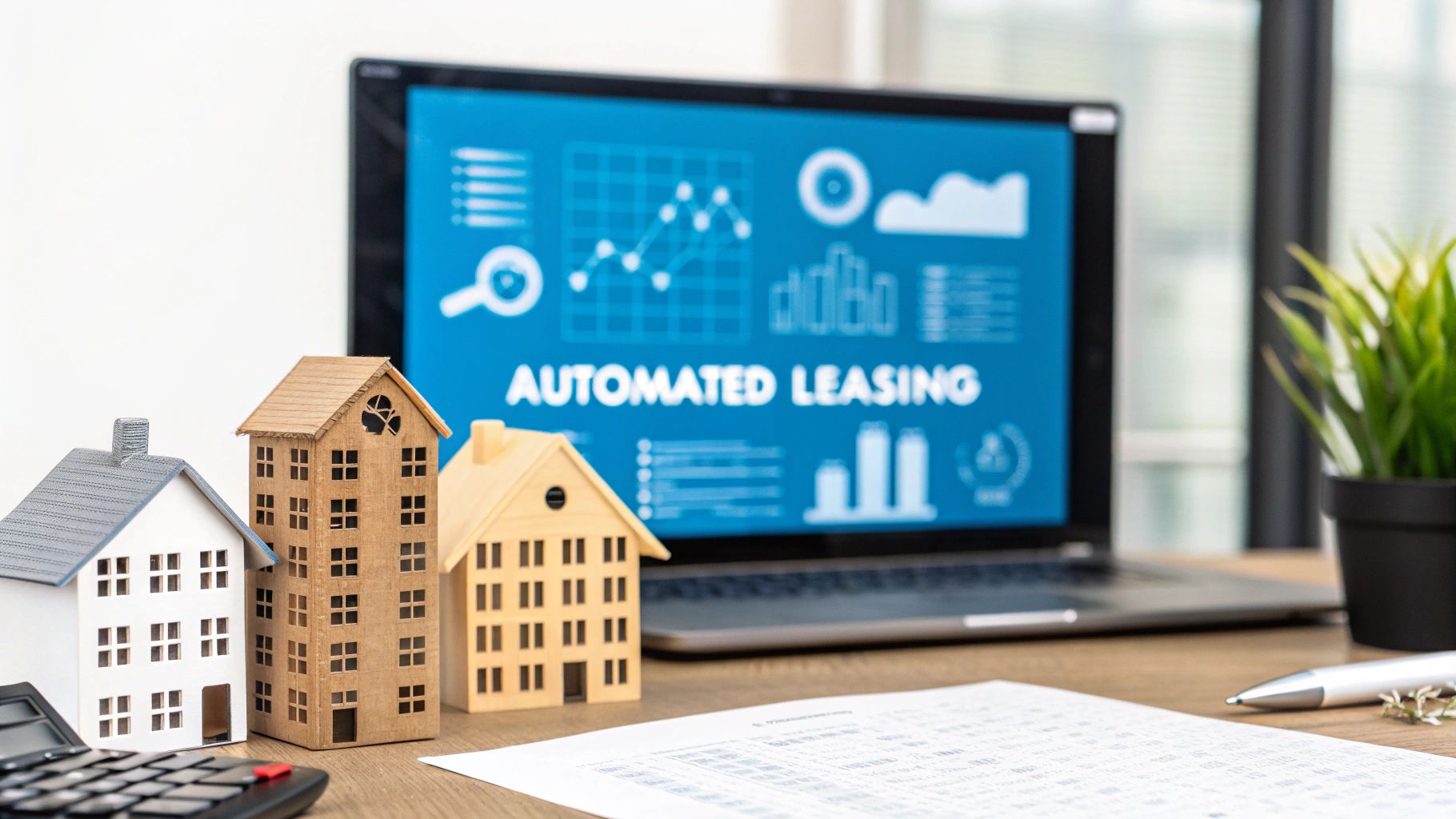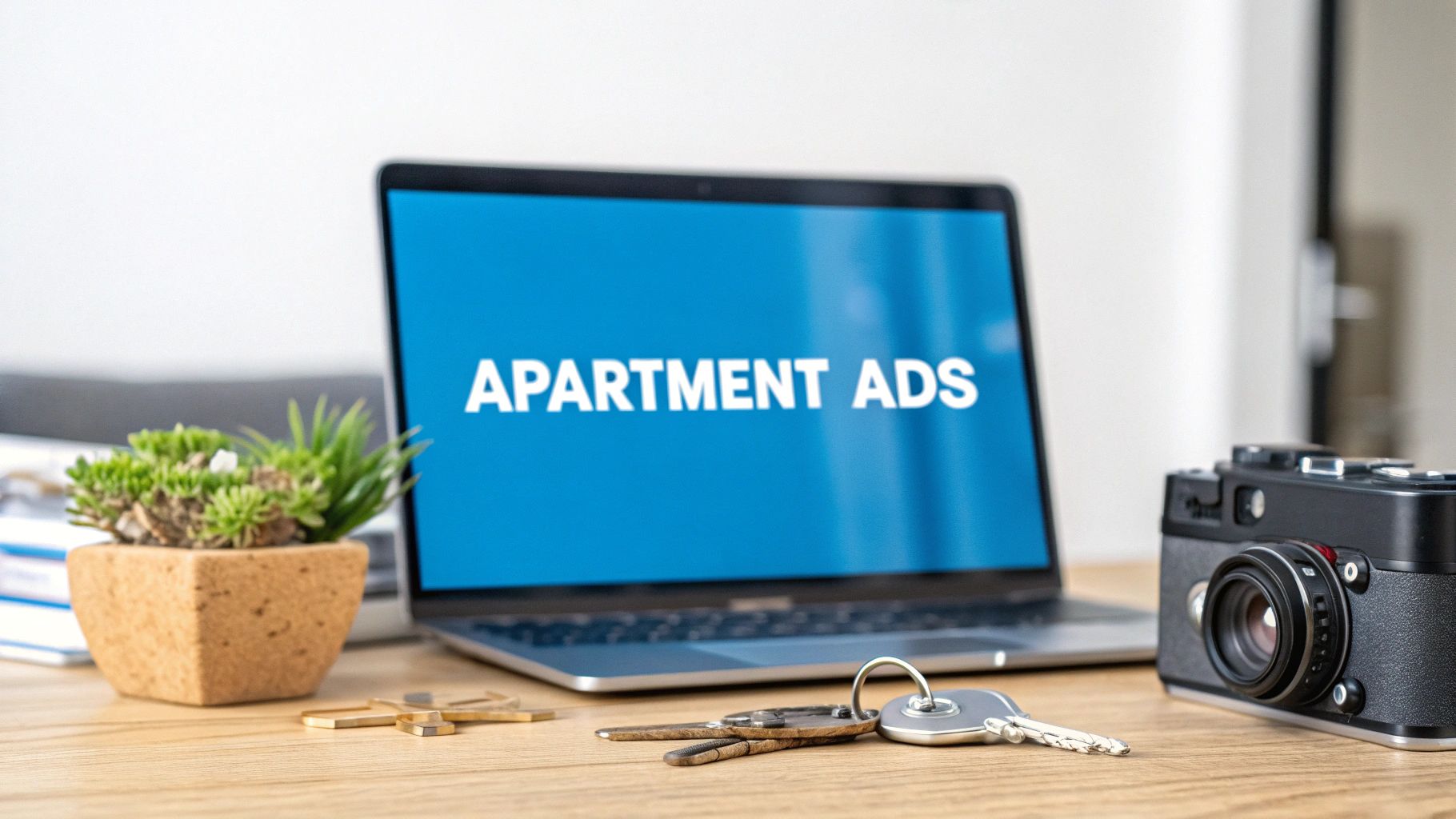For any operations director managing 1,000+ units across multiple markets, automated leasing software for property management has crossed the line from a nice-to-have to essential infrastructure. It's the only scalable way to slash your Days on Market (DOM), standardize operations across your entire portfolio, and drive down your cost per door.
Why Manual Leasing Fails At Scale
Trying to manage a large-scale, distributed portfolio with manual processes is a recipe for revenue loss. The effort is exhausting, the results are painfully slow, and the financial drain is significant.
Every manual phone call, email tag session, and spreadsheet update is a potential bottleneck that directly impacts your bottom line. Every day a unit sits empty is lost revenue you can never recover. At scale, these small operational frictions snowball into a massive financial drag that erodes your Net Operating Income (NOI).
The real killers for large portfolios are the lack of speed and consistency. When your leasing agents are drowning in scheduling showings, manually screening applicants, and chasing down paperwork, they're not focused on high-value activities. This operational drag balloons your DOM, tanks your critical lead-to-tour conversion rates, and creates a disjointed, unprofessional experience for renters across your properties.
The Shift To Automated Operations
Modern rental property management software, especially when supercharged by property management AI, completely flips the script. These platforms put repetitive, time-consuming leasing tasks on autopilot, creating a high-velocity leasing funnel that operates 24/7 without human intervention. Integrating an AI leasing office assistant for rental operations is a game-changer for scaling operations without scaling headcount.
This isn't just about saving a few hours; it's about building a predictable revenue machine. The benefits for large-scale operators are immediate and measurable:
- Accelerate Speed-to-Lease: Instantly respond to every lead, empower prospects to self-schedule tours, and process applications before competitors can even return a call.
- Slash Operational Costs: Dramatically lower your cost per door by automating administrative work, freeing up your leasing teams to manage larger portfolios without burnout.
- Make Data-Driven Decisions: Gain real-time visibility into your entire leasing pipeline, identify performance bottlenecks before they become major problems, and optimize your strategy with accurate data, not guesswork.
The difference between a manual and an automated approach isn't subtle, especially when you're managing hundreds or thousands of units across different cities.
The infographic below paints a clear picture of just how stark the performance gap is.
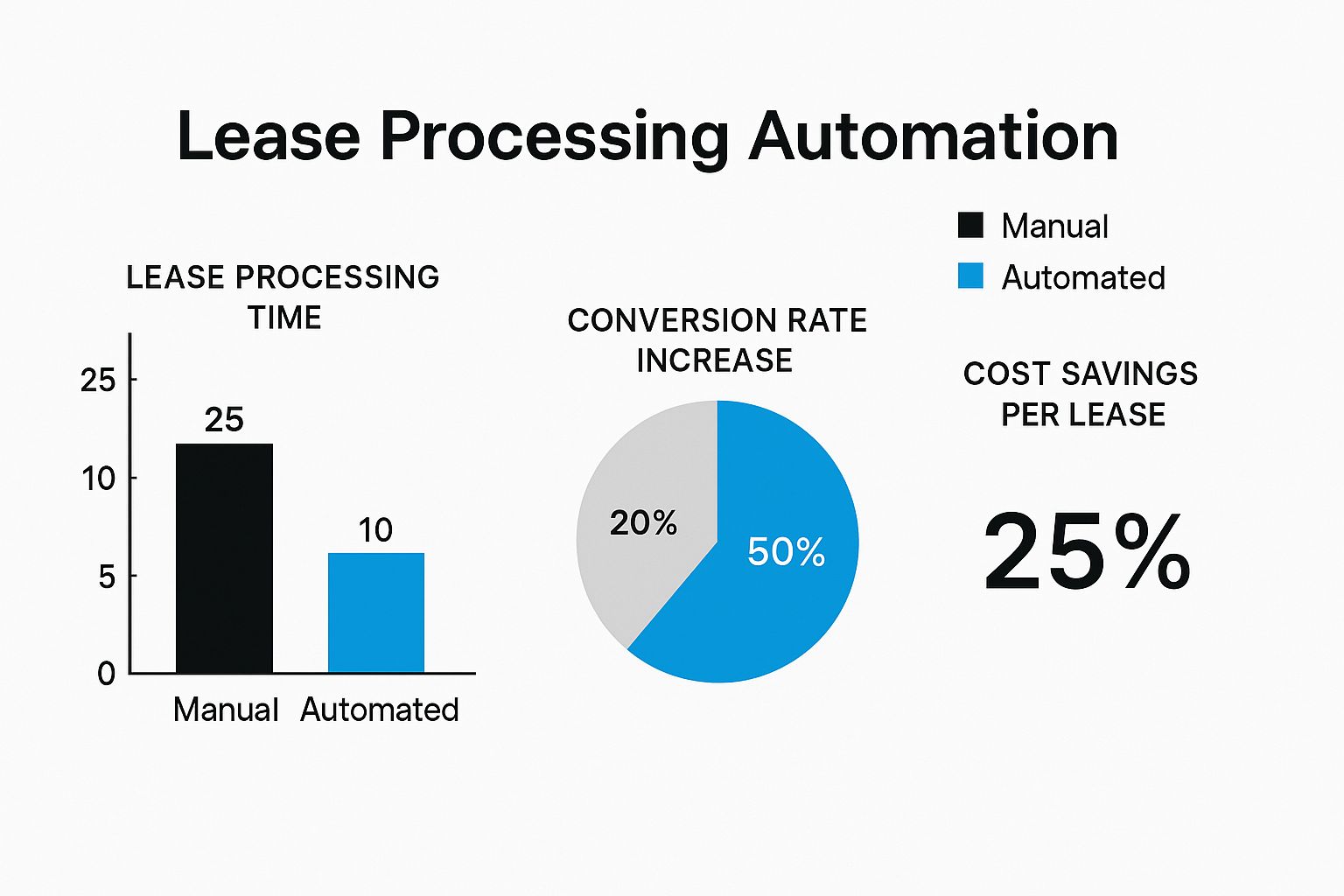
This shift isn't just a trend; it's a fundamental change in how the industry operates. The property management software market is expected to skyrocket from USD 27.95 billion in 2025 to USD 54.16 billion by 2032. This explosive growth is a clear indicator: the old, manual ways are obsolete. For enterprise-level operators, automation is the only path forward to run a lean, efficient operation and maximize portfolio value.
Let's break down what this looks like in practice. When you compare the KPIs of a traditional, manual leasing process to an automated one across a large portfolio, the numbers speak for themselves.
Manual vs. Automated Leasing Funnel Performance at Scale
Ultimately, the table highlights a simple truth: manual processes create friction and delays that are manageable at a small scale but become financially unsustainable as a portfolio grows. Automation removes that friction, creating a smooth, efficient, and profitable leasing engine.
Key Features of Enterprise-Grade Leasing Software
When you're leasing 50 units, your needs are worlds apart from when you're managing 5,000. The software must evolve accordingly. Enterprise-grade platforms aren't just about doing things a little faster; they're about building a predictable, data-driven leasing engine that ensures process standardization across every market you operate in.
For large portfolio managers, the right rental property management software must tie directly into core business objectives. It's a toolkit designed to crush your Days on Market (DOM), maximize lead-to-tour conversions, and drive down your cost-per-door. Anything less wasn't built for scale.
Intelligent Lead Management and Nurturing
At an enterprise level, your team cannot manually sift through thousands of inquiries. It's operationally unfeasible. The best software for property management uses AI to instantly qualify, prioritize, and nurture leads the moment they arrive.
This means a high-intent prospect who asks specific buying-signal questions or perfectly matches your ideal resident profile is automatically flagged and fast-tracked to an agent. This system ensures your team invests their time on leads with the highest probability of signing a lease, dramatically improving conversion rates.
On-Demand and Automated Tour Scheduling
The single biggest bottleneck in any leasing process is the endless back-and-forth of scheduling a tour. Enterprise software eliminates this friction with automated, on-demand scheduling.
Prospective tenants can book a showing 24/7 via a self-service portal that syncs directly with your team’s availability. This is a game-changer for large, distributed portfolios because it achieves two critical goals:
- Maximizes Lead-to-Tour Conversion: You capture renter interest at its peak, converting hot leads before they move on to a competitor's listing.
- Standardizes the Process: Every lead receives the same seamless, professional experience, regardless of the property or city. This consistency is essential for brand integrity and operational control at scale.
For large portfolios, the ability to offer same-day showings is a competitive advantage that directly slashes DOM. The faster you get a qualified prospect through the door, the faster you get a signed lease.
Centralized Communication and CRM Functionality
Managing communications across thousands of units requires more than a shared inbox. Top-tier apps for property management include a built-in CRM that serves as a single source of truth, tracking every email, text, and call with every prospect.
This unified view prevents leads from falling through the cracks and provides invaluable data on response times, engagement rates, and agent performance. For an operations director, this data is gold for identifying pipeline bottlenecks, coaching teams, and optimizing processes. To better understand the options, exploring the best leasing CRMs for your property management business can provide a solid framework.
Seamless Digital Application and Screening
Once a prospect tours a unit, speed-to-lease is paramount. Modern leasing software digitizes the entire application and screening workflow. Prospects can apply online from any device, and the system can execute background and credit checks in minutes, not days.
This speed is a massive competitive advantage. In a competitive rental market, a 24-hour delay can mean losing a high-quality applicant to another property. For large portfolios with significant annual turnover, this feature alone can save thousands in vacancy costs each month. The integration of AI for property management further refines this, flagging potential risks and ensuring screening criteria are applied consistently and fairly across all applicants.
How AI Is Transforming Property Management Operations
If automation handles the repetitive, rule-based tasks in your leasing funnel, then AI for property management is what elevates your operational intelligence to an enterprise level.
Think of it this way: automation follows a pre-defined script. AI learns, predicts, and adapts in real-time. For managers of large, distributed portfolios, this isn't just about doing things faster; it's about building a proactive, data-driven operation that can scale without a linear increase in headcount.
True property management AI is far more than a simple auto-responder. Instead of just sending a canned email, an AI-powered chatbot can engage in a meaningful conversation with a prospect at 2 AM. It can answer complex questions, pre-qualify leads based on conversational context, and schedule a tour—all without human intervention. This instant, intelligent engagement is critical for converting today's on-demand renters.
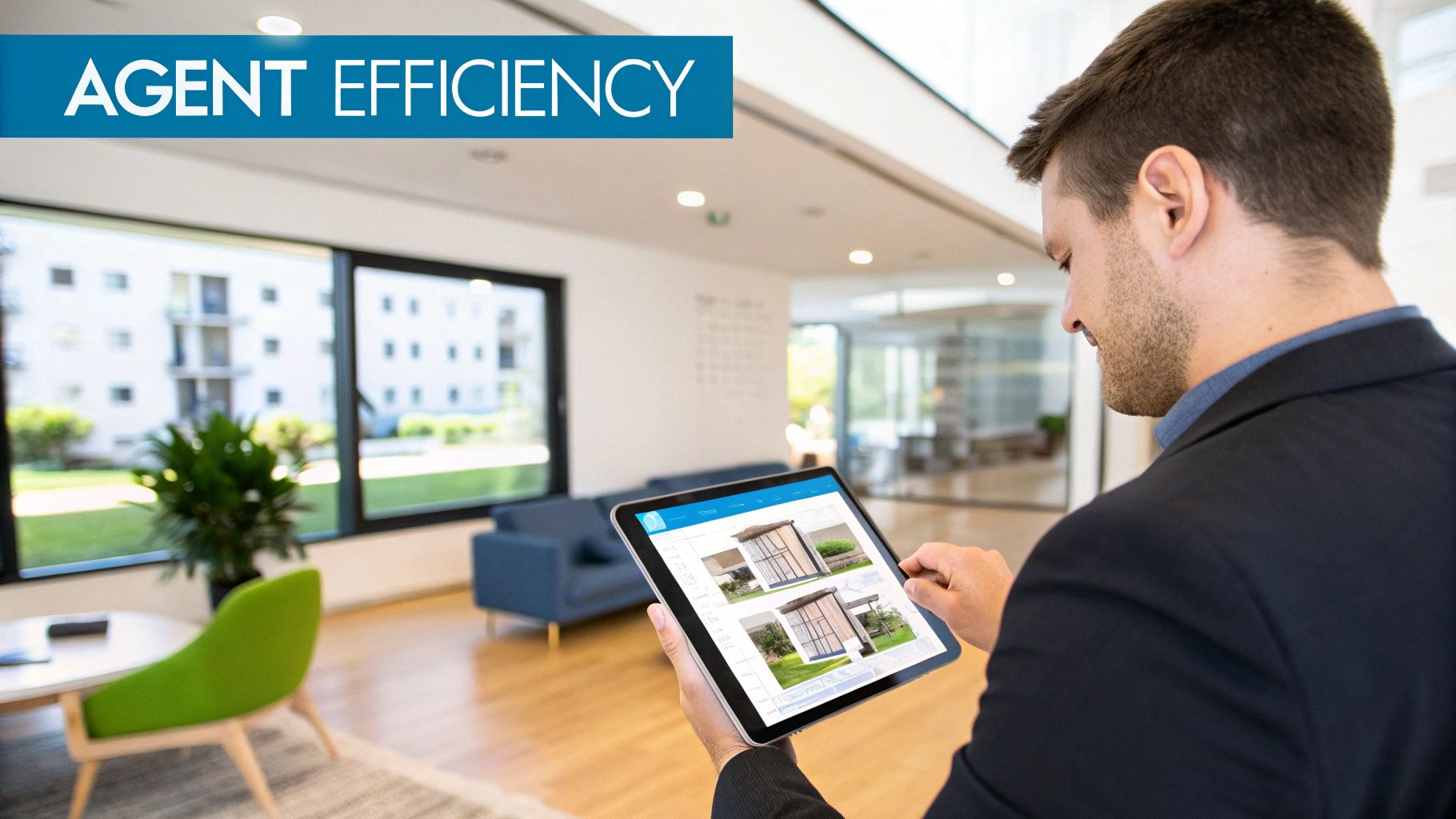
From Reactive to Predictive Operations
By far, the biggest impact of AI in property management is its ability to shift operations from reactive to predictive. Instead of waiting for an HVAC unit to fail during a heatwave or for a high-intent lead to go cold, AI algorithms analyze vast datasets to anticipate future events.
This is a complete game-changer, especially for multi-market portfolios. Imagine an algorithm analyzing years of maintenance records and real-time sensor data to flag a water heater with an 85% probability of failure in the next 30 days. Now you can schedule preventative maintenance, avoid a costly emergency call, and prevent a negative tenant experience.
AI isn't here to replace skilled leasing agents and property managers. It's here to supercharge them. It automates the tedious, analytical heavy lifting so they can focus on what humans do best: building relationships, negotiating complex deals, and driving portfolio growth.
Real-World AI Applications at Scale
This is no longer theoretical. AI is delivering measurable ROI for large-scale operators, moving from industry buzzwords to practical tools that solve major operational challenges.
Here’s where it’s already making a financial impact:
- AI-Powered Applicant Screening: Forget manually sifting through applications. Advanced algorithms can review them in minutes, cross-referencing data and verifying income to flag risks based on your specific criteria, ensuring fair and consistent screening at scale.
- Dynamic Rent Pricing: AI models analyze real-time market data, competitor pricing, and local demand signals to recommend optimal rent prices, maximizing revenue for every unit without overpricing the property.
- Predictive Maintenance Analytics: By monitoring asset performance and historical repair data, AI can predict equipment failures before they happen, reducing emergency costs and improving tenant retention.
- Intelligent Lead Nurturing: AI can score and segment new leads based on their online behavior, then trigger automated, personalized follow-up sequences to keep the most promising prospects engaged and moving toward a tour.
These AI-driven functions are rapidly becoming standard in modern rental property management software. It’s no surprise that the global property management software market is projected to rocket from roughly USD 5.3 billion in 2025 to USD 16.8 billion by 2035. That explosive growth is driven by the clear ROI that AI and automation deliver at scale.
For a deeper technical overview, this AI powered workflow automation explainer guide is a great resource.
Ultimately, integrating AI into your operations creates a sustainable competitive advantage that manual processes simply cannot match. It empowers you to make smarter, faster, and more profitable decisions across your entire portfolio.
Crunching the Numbers: The Real ROI of a Faster Leasing Cycle
For property managers running large-scale operations, speed isn't just a convenience—it's a core financial driver. Every day a unit sits empty is a direct hit to your bottom line. This is where automated leasing software for property management proves its worth, turning a faster leasing cycle into tangible, measurable gains for your Net Operating Income (NOI).
Calculating the true cost of vacancy is the key to understanding the incredible ROI of shrinking it. This isn't about fuzzy metrics or "efficiency"—it's about putting a hard dollar amount on every day you can win back.

Step 1: Calculate Your Daily Vacancy Cost
First, you need a baseline. While the total cost of vacancy includes utilities, marketing, and staff time, the most significant factor is lost rent.
The formula is straightforward:
Daily Vacancy Cost per Unit = (Average Monthly Rent) / 30 Days
If your portfolio's average rent is $1,800 per month, your daily vacancy cost is $60 for every empty unit. This $60 is the foundational number for your entire ROI calculation.
Step 2: Quantify Your Current Annual Vacancy Loss
Now, let's project this daily cost across your portfolio using your current average Days on Market (DOM). DOM is the ultimate report card for your leasing velocity, and it has a massive impact on revenue.
Let's run a scenario for a 1,000-unit portfolio with an industry-average DOM of 21 days and a 50% annual turnover rate.
- Units Turning Over Annually: 1,000 units x 50% = 500 units
- Total Vacant Days Per Year: 500 units x 21 DOM = 10,500 days
- Total Annual Vacancy Cost: 10,500 days x $60/day = $630,000
That's $630,000 in potential revenue lost to vacancy alone. This staggering figure also highlights the immense financial opportunity hidden within your leasing process.
Every day shaved off your DOM is a direct deposit to your NOI. For large portfolios, these "small" wins quickly compound into hundreds of thousands of dollars in recovered revenue.
Step 3: Project Your Revenue Gains from Automation
This is where the business case becomes undeniable. Let's see what happens when you implement AI in property management and automation tools designed to slash your leasing timeline. Modern platforms can realistically cut DOM by a week or more by providing instant lead response, 24/7 tour scheduling, and accelerated applications. (For more strategies, see our guide on how to lease your properties quicker in 2024).
What is the financial impact of cutting just seven days from your DOM, reducing it from 21 to 14?
- New Total Vacant Days: 500 units x 14 DOM = 7,000 days
- New Annual Vacancy Cost: 7,000 days x $60/day = $420,000
- Annual Revenue Recovered: $630,000 - $420,000 = $210,000
By trimming just one week from your average leasing cycle, you’ve recaptured over two hundred thousand dollars in pure revenue.
This simple calculation proves that modern rental property management software isn’t an expense; it’s a revenue-generating engine that can deliver a significant return on investment.
To make this even clearer, the table below projects the revenue impact of DOM reduction across portfolios of different sizes.
DOM Reduction Revenue Impact Calculator (Sample Portfolio)
Based on $1,800 average rent ($60/day) and 50% annual turnover.
As you can see, the savings aren't just incremental—they're exponential. For a 5,000-unit portfolio, cutting the leasing cycle in half can recover over $2 million a year. The numbers speak for themselves.
Choosing the Right Software for Your Portfolio
Selecting the right rental property management software is a core business decision that will either accelerate your growth or become the bottleneck that constrains it. For large-scale portfolio managers, the stakes are incredibly high. A platform that cannot scale as you add doors will quickly become a liability, creating costly inefficiencies across your operation.
The market is crowded, but many solutions are designed for small-scale landlords and lack the infrastructure to handle thousands of units across multiple markets. You must look past marketing claims and identify a technology partner built for the complexities of enterprise-level management—one that understands your obsession with metrics like Days on Market (DOM) and lead-to-tour conversion rates.
This requires a rigorous evaluation process focused on a few key pillars that support sustainable, scalable growth.
The Enterprise Evaluation Checklist
When vetting potential software, a simple feature comparison is insufficient. You need to pressure-test the platform's core architecture and its ability to handle the volume and complexity of a large, distributed portfolio.
Here are the non-negotiables for finding the best software for property management at scale:
True Scalability: Will the system perform as smoothly with 10,000 units as it does with 100? Request enterprise-level case studies or a direct conversation with a client managing a portfolio at your target scale. The software must handle massive data loads without performance degradation, especially during peak leasing season.
Robust API and Integration Capabilities: Your leasing platform cannot operate in a silo. It must seamlessly connect to your property management system (PMS), accounting software, and other critical tools in your tech stack. A well-documented, open API is essential for creating a unified ecosystem that eliminates data silos and manual data entry.
Workflow Customization: Managing properties in Phoenix is different from managing them in Seattle. Your software must allow you to build and standardize custom workflows across the portfolio while still permitting market-specific adjustments. This flexibility is key to maintaining operational consistency without sacrificing local effectiveness.
Advanced Data Security Protocols: You are the custodian of vast amounts of sensitive tenant and owner data. Scrutinize the vendor's security measures, including data encryption, access controls, and compliance with privacy regulations (e.g., CCPA, GDPR). A data breach at scale is a catastrophe; your software is a critical line of defense.
Future-Proofing Your Technology Stack
The proptech landscape is in constant motion, with new technologies and service models emerging continuously. Apps for property management are becoming smarter and more agile by necessity.
A great technology partner doesn't just solve today's problems; they are already building for tomorrow's. Investing in a forward-thinking platform ensures your operations remain competitive and efficient for years to come, ready to adapt as your portfolio and the market evolve.
Globally, the industry is shifting towards more flexible solutions. For example, hybrid deployment models that combine the accessibility of the cloud with the security of private data management are growing at a compound annual rate of nearly 14%. This indicates that rigid, one-size-fits-all systems are becoming obsolete.
As you evaluate your options, consider the company's commitment to innovation. What is on their product roadmap for advancements in AI for property management? For a comprehensive market overview, it's worth exploring a full property management software market analysis.
Ultimately, choosing the right automated leasing software is about finding a strategic partner. You need a solution that meets your current needs while providing the scalable, secure, and integrated foundation required to achieve your most ambitious growth objectives. It’s an investment in the future of your portfolio.
Implementing Automation Across a Multi-Market Portfolio
Rolling out new technology across a distributed portfolio is far more complex than flipping a switch. For property managers operating in multiple markets, a successful launch of automated leasing software hinges on a strategic, phased implementation. A flawed rollout can lead to operational chaos, but a well-executed plan will drive down your Days on Market (DOM) and standardize excellence across every location.
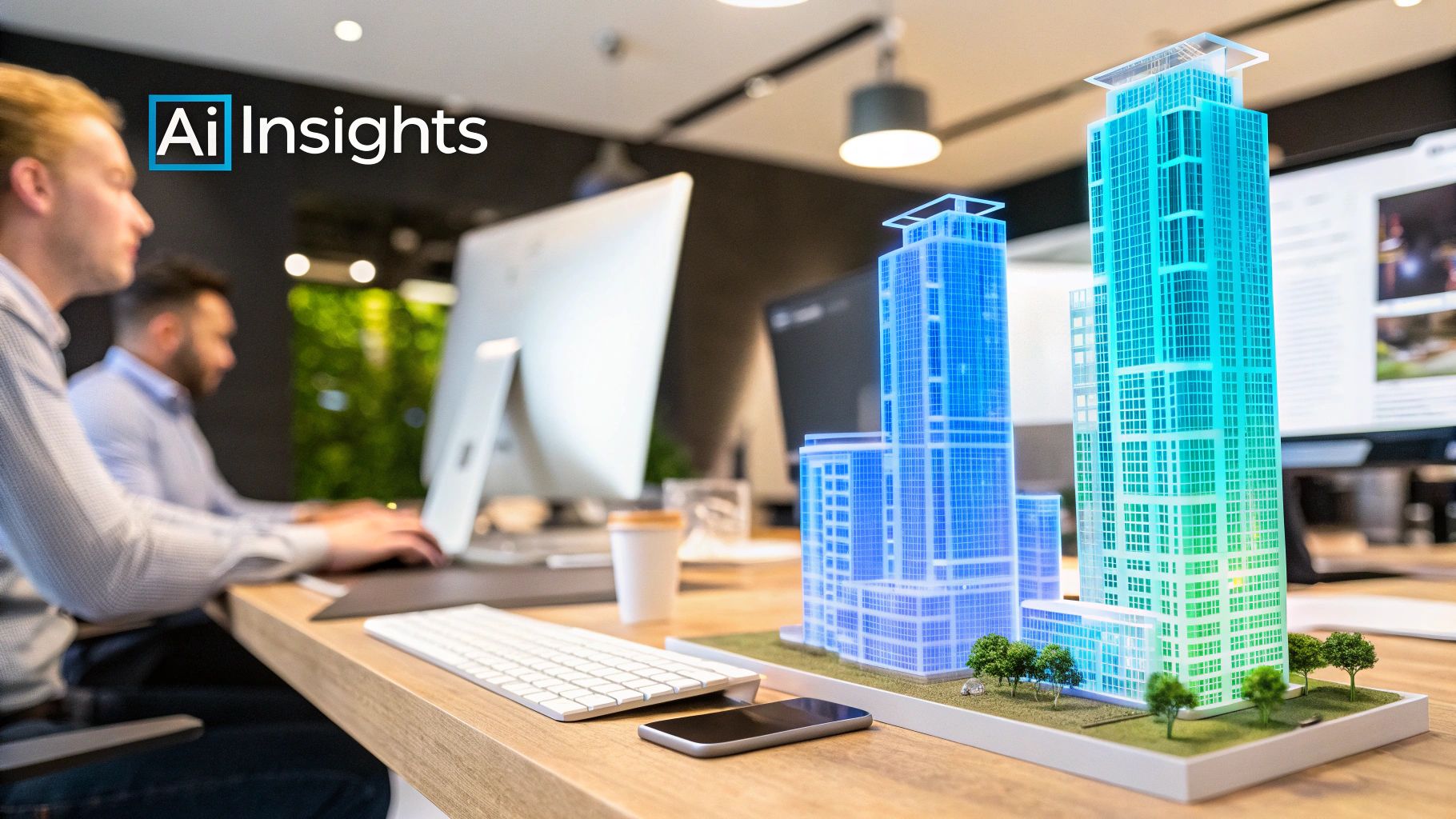
The goal is to create a repeatable implementation framework—one that moves from a controlled pilot to a full portfolio-wide deployment. This approach allows you to mitigate risk, refine processes, and build momentum before a full-scale launch.
Phase 1: The Pilot Program
Start small to win big. Select a single, representative market for a pilot program. This is your opportunity to gather real-world performance data and prove the business case before committing significant resources.
Before launch, define your success metrics. You must establish clear Key Performance Indicators (KPIs) to measure the impact against your current baseline.
KPIs to Track:
- Days on Market (DOM): The ultimate measure of success. Track the average DOM for pilot properties before and after implementation.
- Lead-to-Tour Conversion Rate: Is the new system converting more inquiries into scheduled tours? This metric is critical.
- Cost Per Showing: Calculate the total cost (staff time, resources) of each showing to quantify efficiency gains.
- Leasing Agent Adoption: Monitor user engagement within the platform. If agents aren't using the software, the investment is wasted.
This focused test will provide the hard data needed to justify a portfolio-wide rollout to stakeholders.
Phase 2: Standardize and Train
Once your pilot demonstrates success—for example, a 15% reduction in DOM or a 20% increase in lead-to-tour conversions—it's time to standardize. Codify the successful pilot workflows into clear Standard Operating Procedures (SOPs). This ensures every leasing agent, regardless of location, follows the same optimized process.
Effective training is what translates technology into tangible results. Training should be role-based, hands-on, and focused on how the new rental property management software makes your team's jobs easier and more effective.
Standardization isn't about creating rigid, unchangeable rules. It's about establishing a high-performance baseline that eliminates guesswork and delivers a consistent, high-quality experience for every prospect across your portfolio.
Phase 3: Scaled Rollout and Continuous Optimization
With proven SOPs and a robust training program, you can begin rolling out the system market by market. This phased expansion prevents support teams from being overwhelmed and allows for adjustments based on regional nuances. Maintain open feedback channels to foster a culture of continuous improvement.
As you expand, keep a close watch on your KPIs. Data provides an objective measure of performance, highlighting what’s working and what needs refinement. Implementing AI in your property management is not a "set it and forget it" project. By continuously tracking performance and iterating on your strategy, you ensure the technology delivers a compounding return on investment as your portfolio grows.
Still on the Fence About Leasing Automation and AI? Let's Talk.
Adopting new technology always comes with a few "what ifs," especially when you're managing a large portfolio. It's smart to have questions. Getting clear, straightforward answers is the only way to make a strategic move that actually pushes your growth goals forward.
Here are the most common questions we hear from property managers about bringing automated leasing software and AI into their operations.
Will This Actually Work With Our Current PMS?
This is usually the first—and most important—question. And the short answer is: yes. Any serious software for property management today is built to play nice with others.
Enterprise-level platforms are designed with open APIs (think of them as universal adapters) that let them plug directly into major systems like AppFolio, Yardi, or RentManager. This connection ensures all your leasing data flows where it needs to go automatically, so you're not stuck with manual double-entry. Everything stays perfectly synced between your leasing, operations, and accounting.
How Much Training Will My Leasing Agents Need?
The phrase "AI in property management" might sound intimidating, but modern tools are designed for busy people, not tech wizards. The whole point is to make your leasing agents’ lives easier, not to turn them into coders.
Most platforms offer solid onboarding and training that’s built around your team's workflow. The day-to-day stuff—like tracking leads or seeing where a tour is in the process—is incredibly intuitive and can usually be picked up in just a few sessions. The system does all the heavy lifting in the background, freeing your team up to focus on what they do best: building relationships and closing leases.
The real shift isn't about learning complex software; it's about adopting a more efficient workflow. The technology is simply the tool that enables your team to close leases faster and manage larger portfolios without burnout.
Can an AI Really Talk to Potential Tenants?
We get it—it’s natural to be skeptical about a bot handling prospect conversations. But today’s property management AI is light-years beyond the clunky chatbots of the past. These systems use natural language processing to actually understand what people are asking.
They can field specific questions about pet policies or kitchen appliances, pre-qualify leads based on your exact criteria, and give every single inquiry an instant, professional response—24/7. Think of it as a tireless front line that never misses a lead.
For a deeper dive, check out our guide on using ChatGPT as a leasing assistant. It breaks down how this technology handles those crucial first conversations, so your agents only spend time on prospects who are truly ready to move forward.
Ready to see how the right technology can slash your Days on Market and transform your leasing operations? Showdigs combines intelligent automation with a network of on-demand showing agents to get your properties leased faster than ever. Schedule a demo today and discover a smarter way to manage your portfolio at scale.




